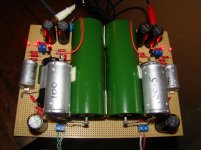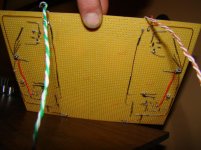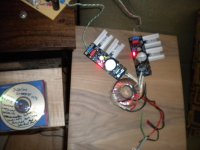The FT were a good bypass experiment with enough types. Recommended for a try out. 0.22uF not too big, its 1/10 to the main one you discuss.
I wanted to post a couple of pics of my latest build. I also wanted to extend a big thank you to salas who is unbelievably generous with his time and knowledge. I will box this up in two chassis this weekend. Even sitting in the open and picking up some hum this sounds great. I thought I might need a bigger output cap, but listening I'm not sure I do. Every question I had was already asked and answered in the thread. OK enough wasted time...back to listening and making dinner for the family...
Thanks again, Evan
Thanks again, Evan
Attachments
Wow, chunky! Happy listening!
Big value is counter intuitive for rumble, so 2.2uF for driving down to 20K line pre or 3u3 down to 10K line pre is just about fine.
Big value is counter intuitive for rumble, so 2.2uF for driving down to 20K line pre or 3u3 down to 10K line pre is just about fine.
Every question I had was already asked and answered in the thread. OK enough wasted time...back to listening and making dinner for the family...
Thanks again, Evan
A small hint. Try put a finger on the metal enclosed FT caps. If hum plays up when doing that, ground their cans to the PSU ground return point on the phono board. Maybe only the 47n ones and 0.1u inter-stages can suffer fields due to they couple a low signal still. CAT-5 single strands touching each Alu can are enough to connect them to ground efficiently and make them shields to their foils.
Thanks for the advice...will do. My chassis will be here tomorrow. I have gotten away with wooden enclosures on my other pieces of equipment, but the phono preamp is much more sensitive. This circuit was my first DIY build, and I am learning that experience building goes a long way towards sound quality, even if I am a far from the level of knowledge floating around here.
Even in the metal chassis (which must be grounded to PSU level GND also), you will find that referencing the metal cans or even closing the lid will reduce hum. There is nothing more sensitive to make for such nuisances than MC phono or studio mic preamp in audio. What is your gain and cart again? I see it can play recordable CDs also in your pic, you evolved it too far in tech.😀
Gain is only 43db. I have an old adcom cross coil cart. I believe it is 2.3mv output. My old build had a slight hum only noticeable with the needle off the record and the volume turned all the way up. I am hoping to do better this time. As it stands this unit already betters the old one. The homemade cd is a relic from some bit torrenting we did for a while...until we got called out by disney for downloading/uploading a movie for the kids, but that is another story.
With that gain is easy to make it utterly silent in a proper box with trafo(s) in another and no AC wires entering the main box. Keep us posted when you will box it up soon.
Hi ,
How about low noise and high yfs JFET 2SK3557 from Sanyo as close replacement for 2SK170.
http://www.onsemi.com/pub/Collateral/2SK3557-D.PDF
How about low noise and high yfs JFET 2SK3557 from Sanyo as close replacement for 2SK170.
http://www.onsemi.com/pub/Collateral/2SK3557-D.PDF
Last edited:
Looks like a BF862 rival. The Philips one claims more max Yfs. Remains to be pitched against in a nVrtHz 1/f test. Such parts are the way to go if SMT testing & soldering is not a problem.
Looks like a BF862 rival. The Philips one claims more max Yfs. Remains to be pitched against in a nVrtHz 1/f test. Such parts are the way to go if SMT testing & soldering is not a problem.
Thanxz Salas,
Soldering smd is fun.😀
These are ready available and low cost alternatives.
Russian PIO for output
Anyone have experimented this kind of capacitors for output decoupling ?
http://i.ebayimg.com/t/OMBG-2-Paper-PIO-capacitor-1uF-200V-10-Lot-12-/23/!BphCRrQBGk~$(KGrHqQOKjYEuhMkfm-IBLryeZH6cQ~~_3.JPG
Anyone have experimented this kind of capacitors for output decoupling ?
http://i.ebayimg.com/t/OMBG-2-Paper-PIO-capacitor-1uF-200V-10-Lot-12-/23/!BphCRrQBGk~$(KGrHqQOKjYEuhMkfm-IBLryeZH6cQ~~_3.JPG
Yes I know them. They have an interesting tonal appeal. But not the most transparent, they are good additions if the rest result leans to ''cold''.
I have a question about enclosures. I got two aluminum boxes from dirty dawg amps (they are nice and priced fairly). If I drill holes in them for ventilation will I compromise there shielding ability?
I have a question about enclosures. I got two aluminum boxes from dirty dawg amps (they are nice and priced fairly). If I drill holes in them for ventilation will I compromise there shielding ability?
circular holes are good.
The frequencies that leak through have wavelengths comparable or shorter than the hole diameter.
Slots are the big problem in leaking lower frequencies.
A lid that is not tightly closed can leave a long slot for medium frequencies to leak in.
How hot does your circuit run? Are venting holes really necessary? I would avoid holes and consider mounting anything that runs hot to the chassis itself. maybe with some insulation pads to avoid ground loops.
I have 2 salas shunt regulators that definitly produce heat. I will mount heatsinks outside the chassis, but don't want to cook the caps.
OK so holes for venting....how small is good....
Use a 3mm drill bit.
- Home
- Source & Line
- Analogue Source
- Simplistic NJFET RIAA



